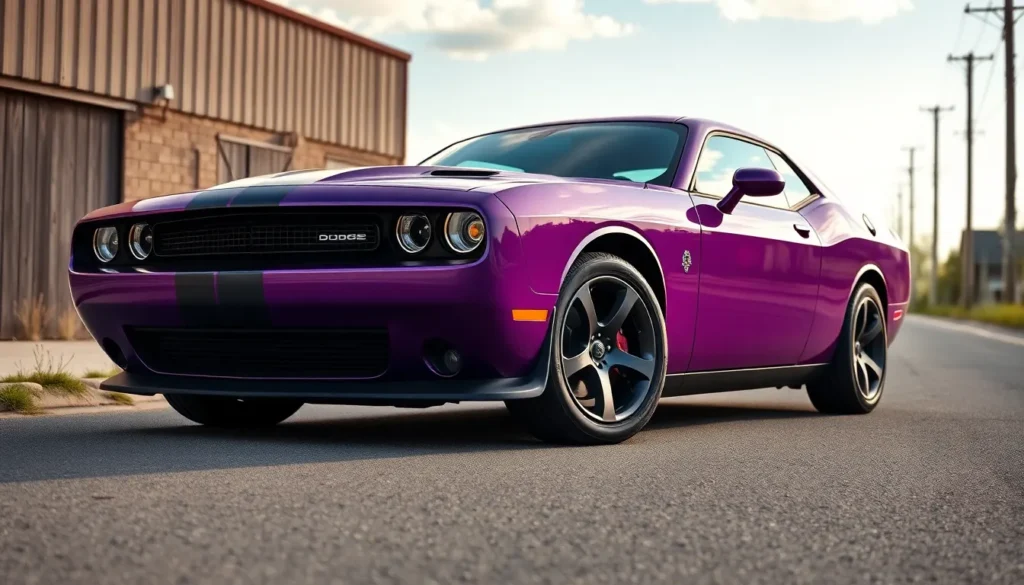The Dodge Challenger’s aesthetic has captured automotive enthusiasts for over five decades with its bold and unmistakable presence. We’ve witnessed this muscle car icon evolve from its 1970s heyday to today’s modern interpretation while maintaining that aggressive stance and powerful silhouette that makes heads turn at every stoplight.
What sets the Challenger apart isn’t just its performance – it’s the complete visual package that screams American muscle. From its wide hood bulges and distinctive split grille to those iconic dual racing stripes we’ve come to love, every design element tells a story of raw power and automotive rebellion.
We’ll explore how Dodge has masterfully balanced retro-inspired design cues with contemporary styling elements to create a vehicle that’s both nostalgic and thoroughly modern. Whether you’re drawn to the classic lines or considering aesthetic modifications, understanding the Challenger’s design philosophy will help you appreciate why this muscle car remains an enduring symbol of American automotive culture.
Classic Muscle Car Heritage That Defines the Dodge Challenger Aesthetic
The Challenger’s aesthetic foundation rests on decades of American muscle car tradition. We see this heritage reflected in every curve and line that pays homage to the golden age of performance vehicles.
Retro-Inspired Design Elements
Bold front fascia design captures the essence of 1970s muscle car aggression with its distinctive dual grille openings. We notice how Dodge maintained the original’s imposing presence while incorporating modern safety standards and aerodynamic improvements. Chrome accents around the grille and headlights create visual depth that mirrors classic muscle car styling cues.
Sculpted hood lines feature pronounced power bulges that hint at the engine’s potential beneath. These design elements aren’t merely decorative—they channel the functional hood scoops and raised profiles that defined original muscle cars. Modern iterations preserve these aggressive contours while integrating contemporary materials and manufacturing techniques.
Wide body stance emphasizes the Challenger’s muscular proportions through flared wheel wells and broad shoulders. We appreciate how this design philosophy creates an unmistakable silhouette that commands attention on any road. The proportions maintain the classic muscle car ratio of long hood to short deck that enthusiasts recognize instantly.
Nostalgic Color Schemes and Racing Stripes
Heritage paint options include iconic colors like Plum Crazy Purple, Go Mango, and TorRed that directly reference the original palette. We’ve observed how these vibrant hues capture the bold spirit of 1970s automotive design when manufacturers weren’t afraid to make dramatic color statements. Each shade tells a story of automotive rebellion and performance heritage.
Dual racing stripes serve as the most recognizable Challenger aesthetic element, available in contrasting colors that create striking visual impact. These stripes extend from the front splitter to the rear spoiler, emphasizing the car’s length and aggressive stance. We see how modern stripe packages offer customization options while maintaining the classic center line design that defines American muscle cars.
Two tone combinations allow owners to recreate period correct color schemes that were popular during the original muscle car era. Options like white bodies with colored stripes or black accent packages provide authentic vintage appeal. These combinations help bridge the gap between classic and contemporary automotive styling preferences.
Authentic Muscle Car Proportions
Long hood configuration creates the classic muscle car profile that immediately communicates power and performance intentions. We observe how this proportion allocates generous space for large displacement engines while maintaining proper weight distribution. The design language speaks directly to enthusiasts who understand that form follows function in true muscle cars.
Short rear deck complements the extended hood by creating visual balance that emphasizes the car’s forward momentum even when stationary. This proportion ratio became the defining characteristic of American muscle cars during their heyday. Modern engineering allows Dodge to preserve these proportions while incorporating contemporary safety and comfort features.
Wide track measurements contribute to the Challenger’s planted appearance and communicate stability at high speeds. We appreciate how the generous wheel spacing creates a confident stance that suggests serious performance capability. These proportions work together with the overall design to create an unmistakable muscle car silhouette that honors the past while embracing the future.
Bold Front Fascia Design That Commands Attention
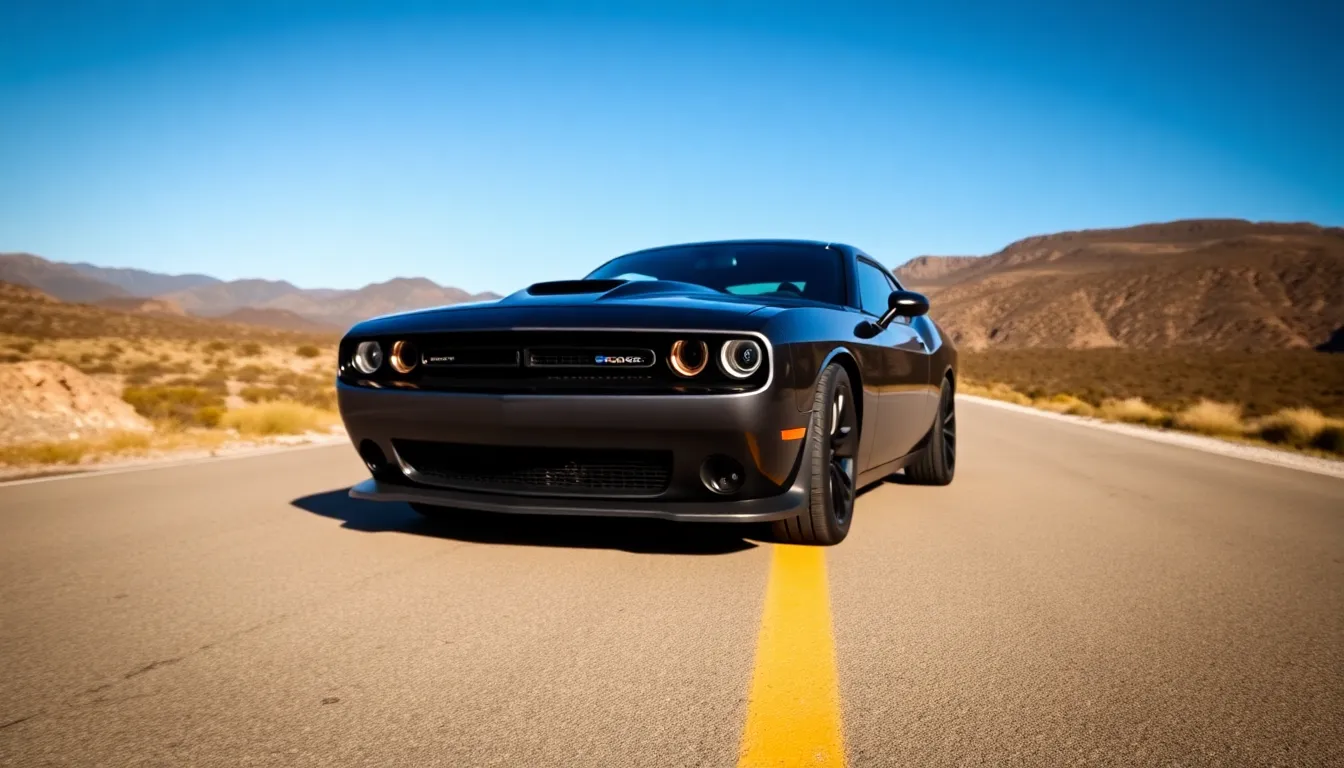
The Challenger’s front end creates an immediate visual impact that establishes dominance on any road. We’ve observed how this commanding presence transforms the driving experience before you even turn the key.
Aggressive Split Grille Configuration
Split grille openings define the Challenger’s menacing front appearance with their distinctive dual chamber design. This configuration features large rectangular openings separated by a central body-colored divider that houses the iconic Dodge crosshair emblem. Black honeycomb mesh fills each grille section, creating depth and texture that enhances the aggressive aesthetic.
Chrome or black trim surrounds the grille openings depending on the trim level, with SRT models featuring blacked-out elements for a more sinister appearance. The grille’s substantial size allows optimal airflow to the engine while maintaining the bold visual statement that muscle car enthusiasts expect. Modern iterations incorporate active grille shutters that improve aerodynamics without compromising the classic split design that connects today’s Challenger to its 1970s heritage.
Distinctive LED Headlight Styling
LED headlights wrap around the front corners with sleek angular shapes that complement the Challenger’s muscular proportions. These modern lighting elements feature distinctive LED daytime running lights that create a signature light pattern instantly recognizable from a distance. The headlight housings integrate seamlessly with the front fascia design while providing superior illumination compared to traditional halogen units.
Adaptive LED technology automatically adjusts beam patterns based on driving conditions and steering input. Black bezels surround the headlight assemblies on performance models, creating a more aggressive appearance that matches the overall aesthetic theme. The lighting design maintains visual continuity with the split grille configuration, ensuring the entire front end works as a cohesive design element.
Prominent Hood Scoop and Air Intakes
Hood scoops provide both functional airflow and visual drama that emphasizes the Challenger’s performance capabilities. These raised sections channel cool air directly to the engine bay while creating aggressive shadow lines across the hood surface. The scoop design varies by trim level, with SRT models featuring larger, more prominent openings that hint at the power beneath.
Functional air intakes located in the front bumper direct cooling air to critical components like the brakes and intercooler. These openings feature mesh inserts that prevent debris from entering while maintaining the clean aesthetic lines. Side air extractors on high-performance models create additional visual interest while serving the practical purpose of reducing air pressure in the wheel wells for improved aerodynamics.
Iconic Side Profile Lines That Create Visual Drama
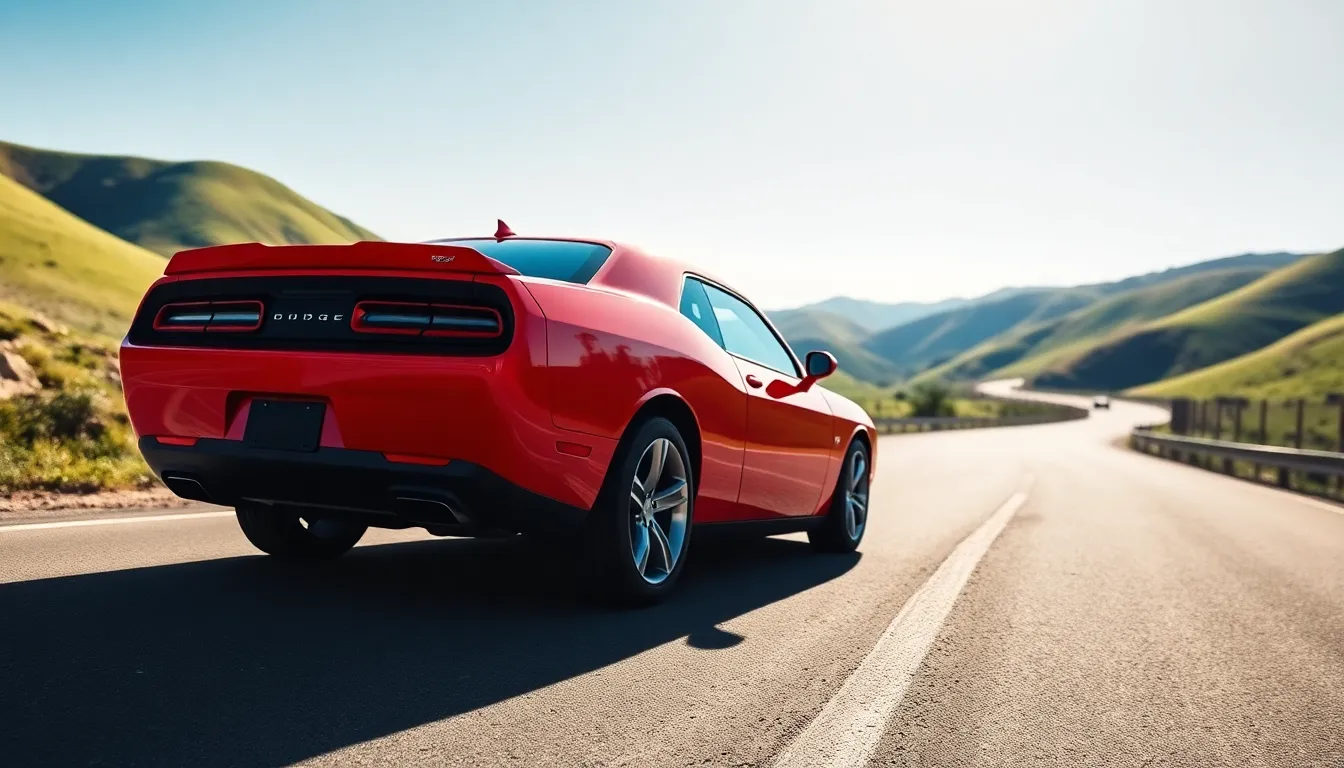
The Challenger’s side profile delivers unmistakable visual impact through carefully crafted design elements. We see how each curve and line works together to create a commanding presence that’s instantly recognizable.
Sculpted Body Panels and Character Lines
Sculptured body panels define the Challenger’s athletic stance through strategically placed curves and surfaces. Deep character lines run horizontally across the doors, creating shadow play that emphasizes the car’s length and power. We notice how the pronounced body side molding creates a visual break between the upper and lower portions of the vehicle.
Character lines flow from the front wheel wells to the rear taillights, establishing visual continuity along the entire body. Sharp creases above the wheel wells add definition and strength to the overall silhouette. We observe that these lines create depth and dimension, preventing the large body panels from appearing flat or monotonous.
Panel sculpting extends to the door surfaces, where subtle curves catch light and create visual interest. Raised sections near the door handles provide functional grip areas while contributing to the overall aesthetic flow. We see how these details work together to transform what could be simple flat surfaces into ever-changing sculptural elements.
Classic Fastback Roofline Silhouette
Fastback rooflines sweep dramatically from the A-pillars to the rear deck, creating the quintessential muscle car profile. The roof slopes continuously without interruption, forming an unbroken arc that communicates speed even when stationary. We appreciate how this design element connects modern Challengers to their 1970s predecessors.
Roofline proportions maintain the classic 2+2 coupe stance with a long hood and shorter rear deck. The rear window angle creates an aggressive rake that enhances the car’s forward-leaning appearance. We notice that the C-pillar treatment varies between trim levels, with some featuring optional rear quarter window louvers.
Silhouette dynamics benefit from the way the fastback design integrates with the rear spoiler options. The continuous line from roof to deck lid creates visual momentum that draws the eye from front to rear. We see how this profile remains distinctive in traffic, making the Challenger instantly identifiable from considerable distances.
Muscular Wheel Wells and Stance
Muscular wheel wells feature pronounced flares that accommodate wide tires while adding visual mass to the vehicle’s corners. The front wheel openings integrate smoothly with the side body panels, creating flowing transitions. We observe how the rear wheel wells receive more aggressive flaring to emphasize the car’s rear-wheel-drive performance nature.
Stance characteristics benefit from the Challenger’s wide track width, which creates a planted appearance on the road. The distance between the wheels and body panels provides room for larger wheel and tire combinations. We notice how the suspension geometry maintains proper wheel positioning while allowing for aftermarket modifications.
Wheel well proportions balance aesthetically with the overall body size, preventing the car from appearing over-tired or under-wheeled. The relationship between wheel diameter and well opening creates visual harmony across different trim levels. We see how these proportions accommodate everything from base model 18-inch wheels to performance-oriented 20-inch options without compromising the design integrity.
Performance-Oriented Rear End Styling
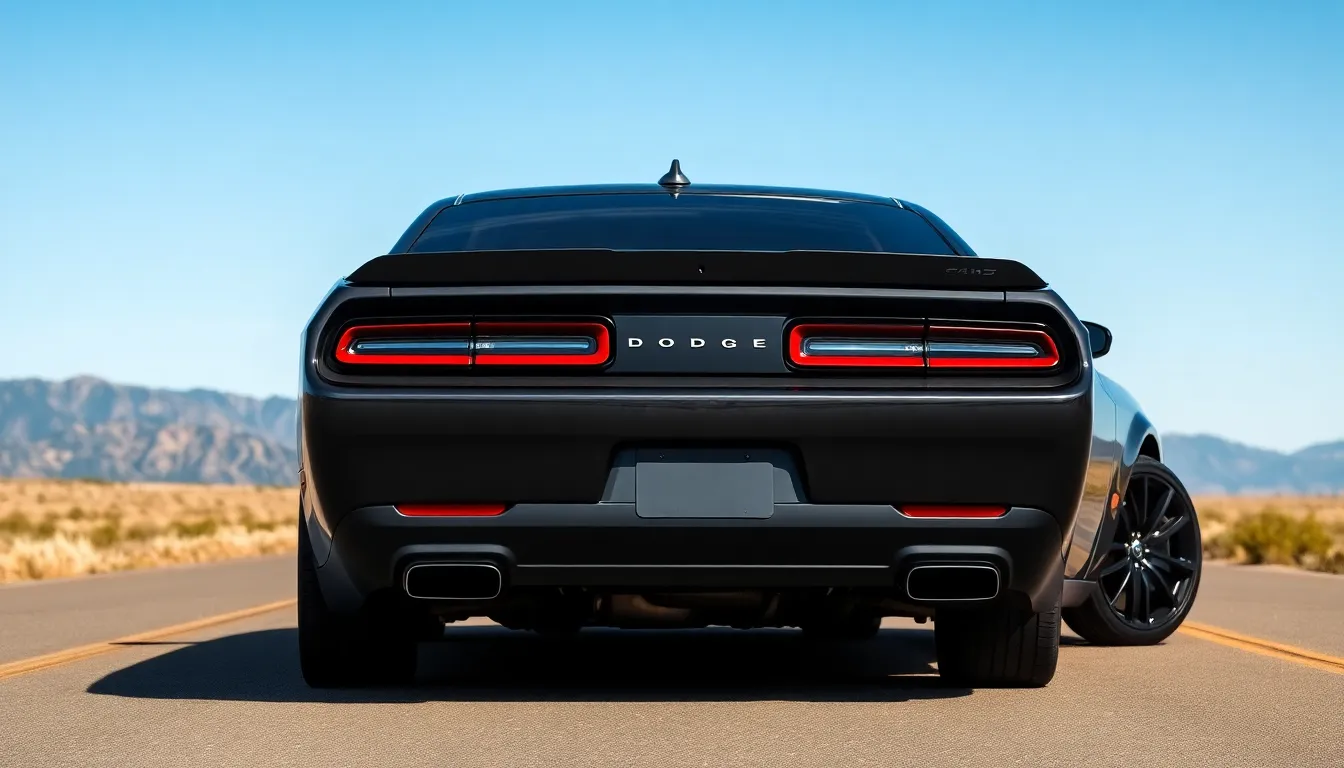
The Challenger’s rear end design completes its aggressive muscle car aesthetic with purposeful styling cues. We see bold elements that emphasize performance while maintaining the classic muscle car proportions established throughout the vehicle.
Dual Exhaust Tips and Diffuser Design
Dual exhaust outlets create an unmistakable sound signature that announces the Challenger’s presence before it’s even visible. We find these chrome-finished tips positioned at the outer edges of the rear bumper, creating visual balance and emphasizing the car’s wide stance. Performance variants like the SRT Hellcat feature larger diameter outlets that accommodate the increased exhaust flow from high-output engines.
Modern diffuser panels integrate seamlessly with the rear bumper design, channeling airflow beneath the vehicle while adding visual drama. We observe how these aerodynamic elements use black or body-colored finishes that complement the overall design theme. Functional air vents within the diffuser assembly help manage rear-end airflow, reducing drag and improving stability at higher speeds.
Split Taillights with Modern LED Technology
Split taillight configurations honor the original 1970s Challenger design while incorporating contemporary LED technology for superior visibility. We appreciate how four distinct light segments create the iconic rectangular pattern that muscle car enthusiasts instantly recognize. Each segment houses exact functions including brake lights, turn signals, reverse lights, and running lights.
LED arrays provide crisp illumination that cuts through various weather conditions while consuming less power than traditional bulbs. We notice how the sequential turn signal operation adds modern flair to the classic design, with lights illuminating in a flowing pattern from inside to outside. Chrome or black trim surrounds each light assembly, allowing owners to customize the appearance based on their preferred aesthetic.
Aggressive Spoiler and Decklid Details
Rear spoilers vary across trim levels, with performance models featuring larger, more pronounced wings that generate actual downforce at highway speeds. We see how SRT variants include functional spoilers with aerodynamic profiles designed in wind tunnels for maximum effectiveness. Standard models often feature smaller lip spoilers that enhance the visual appeal without compromising daily driving comfort.
Decklid surfaces showcase subtle character lines that mirror the hood’s muscular design language, creating visual continuity from front to rear. We observe how raised sections and subtle creases add depth to what could otherwise be a flat surface. Some models include functional air extraction vents that help manage engine bay temperatures, demonstrating how Dodge integrates performance benefits with aesthetic appeal throughout the Challenger’s design.
Interior Aesthetics That Blend Vintage and Modern
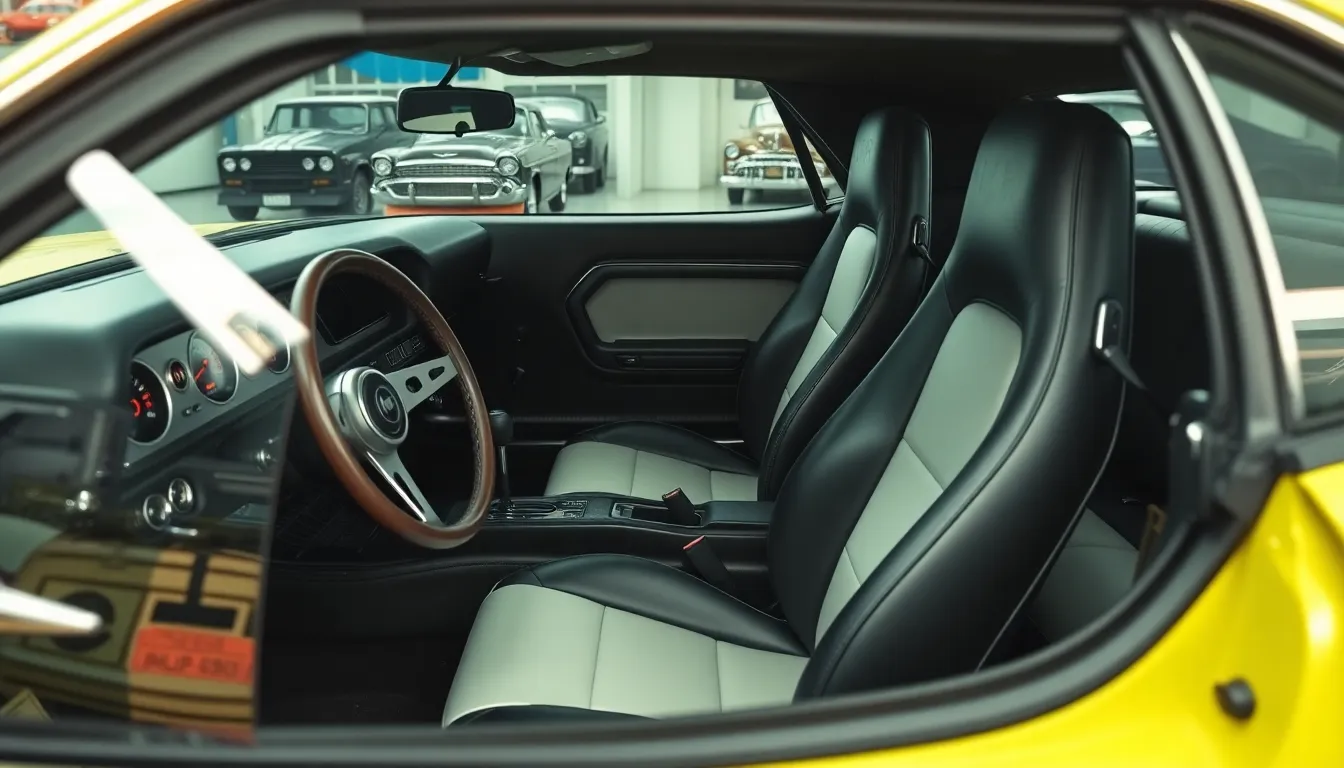
The Challenger’s cabin masterfully bridges five decades of automotive design evolution. We find ourselves surrounded by thoughtful details that honor the original muscle car era while embracing contemporary comfort and technology.
Retro-Inspired Dashboard and Gauge Cluster
Classic gauge designs dominate the Challenger’s instrument panel with deep-set analog dials reminiscent of 1970s muscle cars. We appreciate how the white-faced gauges feature bold numerals and red needles that sweep across traditional markings, creating an authentic vintage experience. Modern LED backlighting illuminates these gauges while maintaining their classic appearance, ensuring excellent visibility in all driving conditions.
Central touchscreen integration seamlessly blends with the retro dashboard layout through careful positioning and proportional sizing. We notice how the 8.4-inch Uconnect display sits flush with the dashboard surface, avoiding the afterthought appearance common in many modern retrofits. Traditional HVAC controls with large, tactile knobs maintain the analog feel while providing precise climate adjustment.
Brushed aluminum trim accents the dashboard with metallic highlights that echo the original Challenger’s industrial aesthetic. We see how these trim pieces frame the gauge cluster and air vents, creating visual continuity throughout the cabin. Piano black surfaces complement the aluminum elements, adding depth and sophistication to the overall design scheme.
Performance Seats with Bold Color Options
Sport bucket seats deliver both visual impact and functional support with deep side bolsters and aggressive contouring. We find that these seats feature premium materials like Nappa leather or Alcantara inserts that enhance grip during spirited driving. Racing-inspired stitching patterns in contrasting colors create visual interest while reinforcing the performance theme.
Color combinations range from classic black leather to eye-catching options like Red Laguna leather with silver stitching. We observe how these bold choices allow owners to personalize their Challenger’s interior aesthetic while maintaining the muscle car character. Heated and ventilated seat functions integrate seamlessly without compromising the seats’ aggressive appearance.
SRT Hellcat variants feature specialized seating with embossed logos and carbon fiber accents that emphasize their high-performance nature. We notice how these seats include additional bolstering and premium materials that justify their position atop the Challenger lineup. Unique stitching patterns and badge details create exclusivity within the already distinctive interior.
Classic Muscle Car Interior Trim Accents
Wood grain trim appears selectively throughout the cabin, echoing the premium muscle cars of the early 1970s. We see this accent on the dashboard, door panels, and center console, where it adds warmth and classic automotive character. Modern manufacturing techniques ensure this trim maintains its appearance over time while providing authentic texture and grain patterns.
Chrome detailing highlights key interior elements like door handles, gear shifter surrounds, and speaker grilles with polished metal accents. We find that these chrome pieces reflect light beautifully, creating visual interest and premium appeal throughout the cabin. Strategic placement ensures the chrome enhances rather than overwhelms the overall design balance.
Vintage-style badging includes classic Dodge logos and model-exact emblems that celebrate the Challenger’s heritage. We notice how these badges appear on the steering wheel, floor mats, and door sill plates, creating brand recognition touchpoints throughout the interior. Special edition models often feature unique badge designs that commemorate exact performance milestones or anniversary celebrations.
Wide Range of Color Options That Define Personality
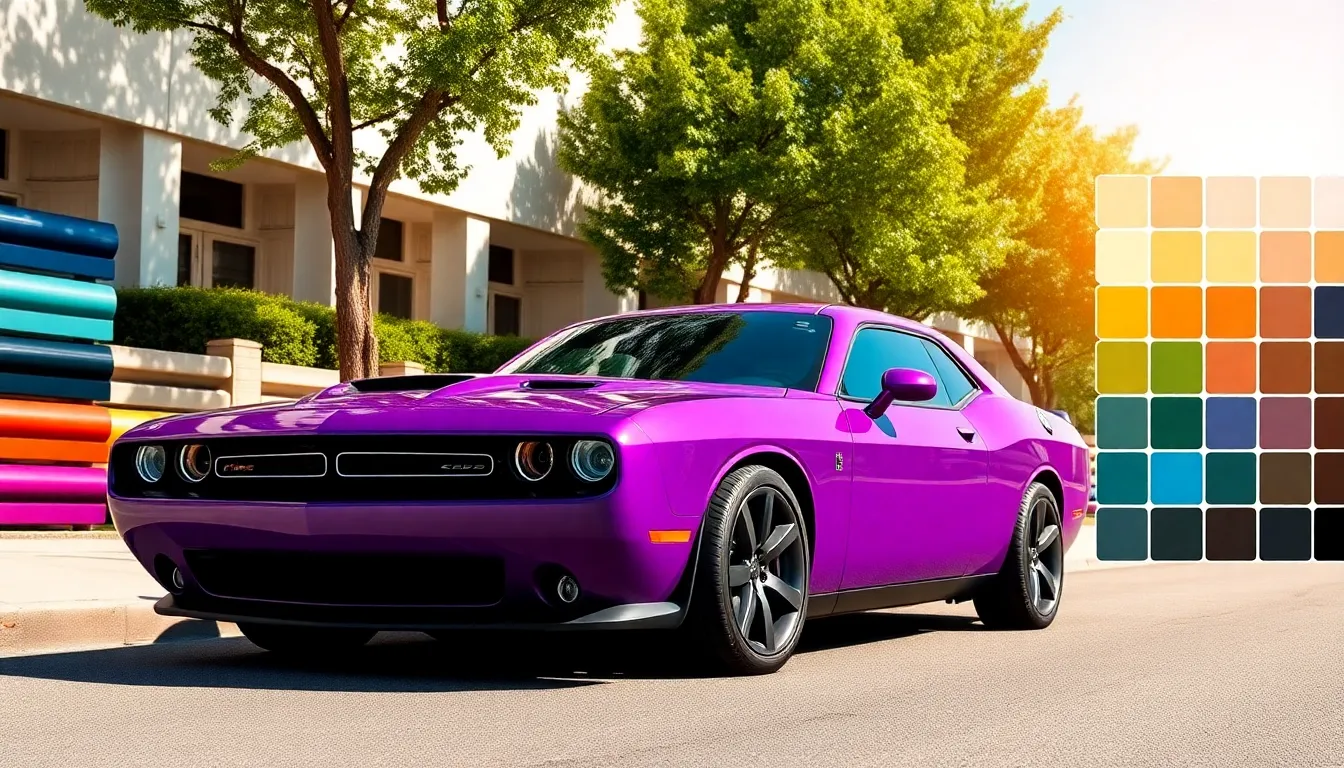
Color choices transform the Challenger aesthetic from bold to breathtaking, allowing owners to express their unique automotive personalities through an extensive paint palette that spans heritage classics to contemporary metallics.
Heritage Paint Colors and Special Editions
Heritage colors bring the golden era of muscle cars into the modern spotlight through authentic paint options that defined the original Challenger lineup. Plum Crazy Purple stands as one of the most iconic heritage shades, capturing the rebellious spirit of 1970s muscle car culture with its vibrant violet hue that demands attention on any street. Go Mango orange delivers another classic option that embodies the high-performance attitude of vintage American muscle, creating an unmistakable presence that honors the Challenger’s racing heritage.
Special edition models elevate these heritage colors through exclusive combinations and limited production runs that increase collectibility. B5 Blue recreates the original factory shade that graced many legendary Challengers, while Sublime green offers a lime-tinged finish that became synonymous with high-performance MOPAR vehicles. These authentic colors connect modern Challenger owners to the rich history of American muscle car design, creating emotional bonds that extend far beyond simple transportation.
Modern Metallic and Pearl Finishes
Contemporary metallic finishes showcase advanced paint technology that adds depth and dimension to the Challenger’s already striking silhouette. Triple Nickel creates a sophisticated gray metallic that shifts between silver and charcoal depending on lighting conditions, providing a refined alternative to traditional bright colors. Granite Crystal metallic offers another premium option that combines dark elegance with subtle sparkle, appealing to owners who prefer understated luxury over bold statements.
Pearl finishes take modern paint technology even further through multi-layered applications that create stunning visual effects. White Knuckle pearl combines classic white with subtle iridescent properties that shimmer in sunlight, while Pitch Black pearl adds depth to what might otherwise be a simple black finish. These advanced coatings require specialized application techniques that result in paint depths impossible to achieve with traditional single-stage colors.
Custom Color Combinations and Graphics Packages
Graphics packages allow Challenger owners to personalize their vehicles through factory-applied designs that complement the base paint color. Dual racing stripes remain the most popular graphics option, available in contrasting colors that run from the front splitter to the rear spoiler, creating visual length that emphasizes the car’s athletic proportions. Hood graphics offer another customization avenue through various designs that highlight the Challenger’s aggressive hood lines and functional air intakes.
Body side graphics provide additional personalization opportunities through accent stripes, model designations, and performance callouts that celebrate exact trim levels. These graphics packages undergo rigorous testing to ensure they maintain adhesion and color stability under various weather conditions, protecting the investment while improving the overall aesthetic appeal. Custom combinations allow owners to create unique looks that reflect their personal style while maintaining the authentic muscle car character that defines the Challenger aesthetic.
Wheel and Tire Combinations That Complete the Look
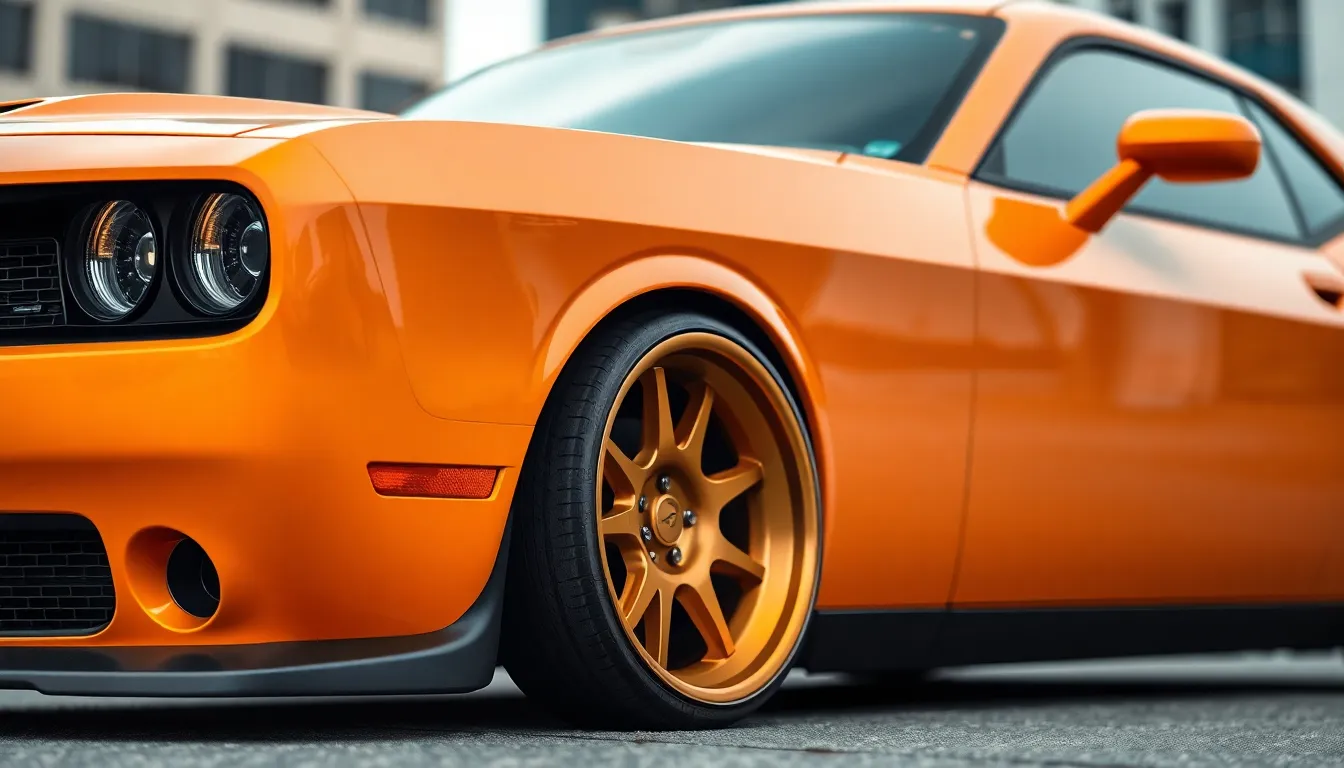
Wheels and tires serve as the foundation that anchors the Challenger’s aggressive aesthetic to the pavement. These rolling elements dramatically influence the car’s overall stance and visual impact.
Factory Performance Wheel Designs
Factory wheel options provide authentic styling that matches the Challenger’s muscle car heritage perfectly. Standard 18-inch aluminum wheels feature a classic five-spoke design that complements the retro-inspired body lines we’ve discussed throughout this exploration of Challenger aesthetics.
Performance-oriented trim levels showcase 20-inch forged aluminum wheels with distinctive spoke patterns that emphasize the car’s wide stance. SRT models feature exclusive wheel designs with aggressive offset measurements that push the tires closer to the fender edges, creating a more planted appearance.
Hellcat variants receive ultra-lightweight forged wheels designed to handle extreme performance demands while maintaining visual appeal. These factory options often include painted accents or machined faces that coordinate with exact exterior color schemes, ensuring cohesive design integration.
Bronze-finished wheels complement heritage colors like Go Mango and Plum Crazy Purple exceptionally well. Satin black finishes create dramatic contrast against lighter paint options while maintaining the aggressive character we’ve established as central to Challenger design philosophy.
Aftermarket Styling Options
Aftermarket wheel manufacturers offer extensive customization opportunities that enhance the Challenger’s already commanding presence. Popular brands create designs specifically engineered for the Challenger’s unique bolt pattern and weight requirements.
Vintage-inspired designs recreate classic muscle car wheel aesthetics using modern materials and manufacturing techniques. Rally wheels with trim rings provide authentic 1970s styling while incorporating contemporary safety standards and performance capabilities.
Forged aluminum options reduce unsprung weight compared to factory wheels while offering unlimited finish possibilities. Custom powder coating allows owners to match wheels precisely to interior accents or create striking contrast effects that emphasize the car’s bold proportions.
Multi-piece wheel constructions enable mixing different finishes on individual components for truly unique appearances. Split-spoke designs showcase large brake calipers while maintaining the muscular aesthetic that defines Challenger styling throughout all exterior elements.
Deep concave profiles create dramatic shadows that accentuate the Challenger’s wide fender flares and aggressive stance. Stepped lip designs add visual depth while maintaining proper fitment within the sculpted wheel wells we’ve previously examined.
Tire Selection Impact on Overall Aesthetic
Tire selection significantly affects both the Challenger’s visual stance and its connection to muscle car tradition. Wide performance tires fill the wheel wells completely, eliminating gap spaces that diminish the car’s planted appearance.
Sidewall profiles directly influence the overall aesthetic balance between wheels and tires on the Challenger. Lower profile tires showcase wheel designs more prominently while maintaining the aggressive stance that complements the hood scoop and front fascia elements.
All-season tire options often feature sidewall designs that coordinate with performance-oriented aesthetics without compromising daily drivability. Summer performance compounds provide maximum contact patch width, emphasizing the muscular proportions that define authentic muscle car styling.
Drag racing tires create the ultimate aggressive stance for track-focused builds while honoring the Challenger’s performance heritage. These specialized compounds often feature raised white lettering that connects modern builds to classic muscle car traditions.
Tire manufacturer branding becomes part of the overall visual package, with certain brands carrying stronger associations with American muscle car culture. Matching tire sizes front to rear maintains balanced proportions, while staggered setups emphasize the rear-wheel-drive performance character that defines the Challenger driving experience.
Trim Levels That Offer Distinct Visual Personalities
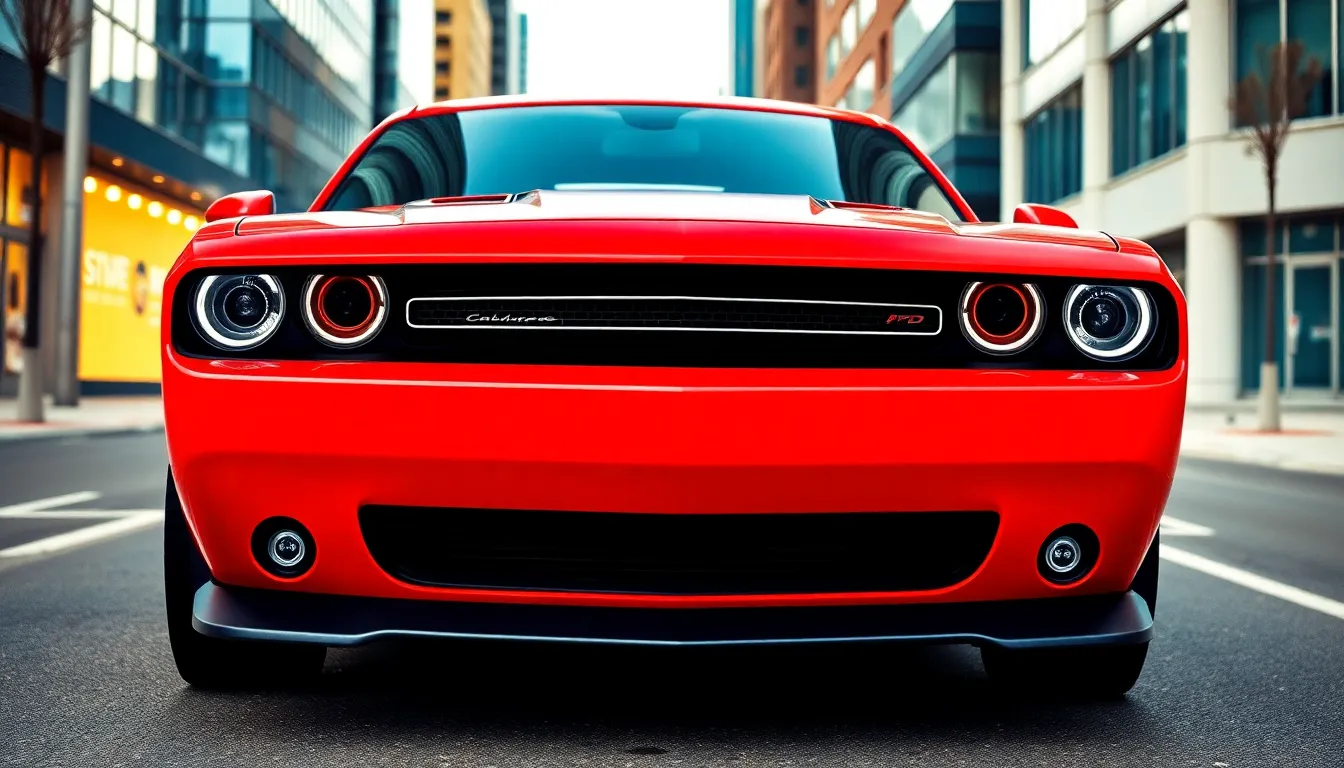
Each Challenger trim level presents a unique visual identity that showcases different aspects of the muscle car aesthetic. We’ll explore how Dodge crafts distinct personalities across its lineup.
SXT Base Model Styling Elements
Standard design features establish the SXT as an accessible entry point into Challenger ownership while maintaining authentic muscle car proportions. Chrome accents surrounding the split grille create a refined appearance that honors the heritage design without overwhelming the front fascia. Body colored door handles and mirror caps provide a cohesive exterior finish that emphasizes the car’s clean lines.
Wheel configurations on the SXT typically include 18-inch aluminum wheels with a five-spoke design that complements the car’s classic stance. Integrated fog lamps enhance both functionality and visual appeal by adding depth to the lower fascia design. Standard halogen headlights maintain the distinctive quad-eye appearance while providing adequate illumination for daily driving needs.
Exterior trim details feature black plastic accents on the lower body cladding and rear diffuser that create visual contrast without adding aggressive styling elements. Chrome exhaust tips provide a subtle performance hint while maintaining the refined aesthetic that appeals to a broader audience. Body side moldings protect the paint while adding subtle definition to the Challenger’s sculpted profile.
R/T Performance Visual Upgrades
Performance oriented styling transforms the R/T into a more aggressive variant through carefully selected visual enhancements that signal increased capability. Blacked out grille surrounds replace the chrome accents found on base models, creating a more menacing front end appearance. Functional hood scoops become standard equipment, channeling air to the performance engine while adding dramatic visual impact.
Wheel and tire packages upgrade to larger 20-inch aluminum wheels with performance-oriented designs that fill the wheel wells more completely. Red Brembo brake calipers peek through the spokes on certain R/T variants, adding a splash of color that hints at the stopping power within. Wider performance tires enhance the planted stance while communicating the car’s increased performance capabilities.
Distinctive badging throughout the exterior identifies the R/T as a performance model through heritage-inspired emblems and graphics. Side exhaust exits replace rear-mounted tips on some configurations, creating a more aggressive exhaust note and visual drama. Performance rear spoilers add functional downforce while contributing to the more athletic rear profile that distinguishes R/T models from their base counterparts.
SRT Hellcat Extreme Aesthetic Features
Supercharged styling elements push the Hellcat’s appearance to the extreme through functional aerodynamic components and aggressive design cues. Widebody flares on certain Hellcat variants accommodate massive 305mm rear tires while creating an intimidating presence that dominates any parking lot. Functional air extractors in the hood channel heat away from the supercharged engine while adding dramatic visual elements.
Track focused aerodynamics include front splitters, rear spoilers, and side sills that enhance both performance and visual drama. Carbon fiber accents replace traditional trim pieces throughout the exterior, reducing weight while adding premium aesthetic appeal. Brembo brake packages with massive rotors and colorful calipers provide stopping power that matches the extreme performance capabilities.
Exclusive design details set the Hellcat apart through unique badging, special paint options, and performance-oriented trim pieces. Adaptive LED headlights provide superior illumination while maintaining the aggressive front end design that signals the car’s extreme performance potential. Quad exhaust tips with distinctive shapes create a signature sound while adding visual weight to the rear fascia that balances the car’s overall proportions.
Customization Options That Enhance the Dodge Challenger Aesthetic
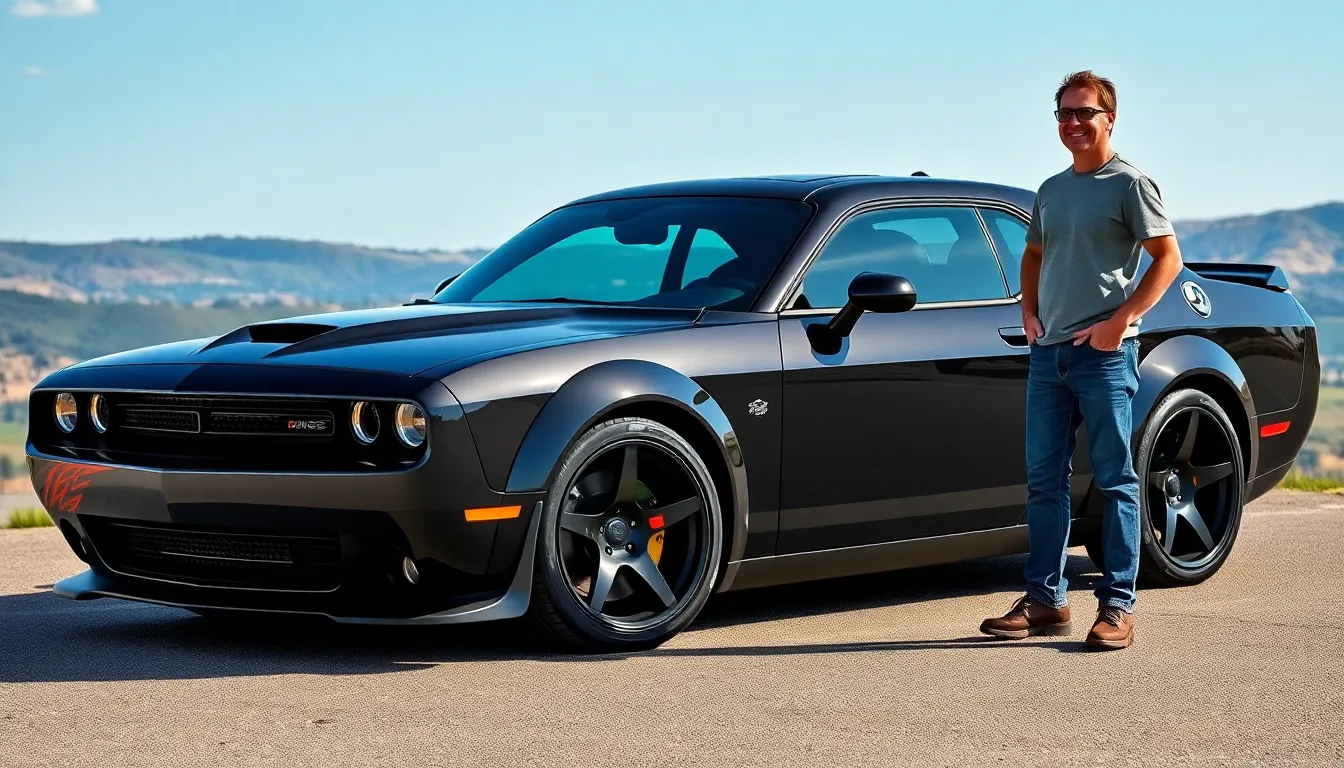
We’ve explored how the Challenger’s design captivates enthusiasts straight from the factory, but the real magic happens when owners make it their own. Customization transforms an already striking muscle car into a personalized statement of automotive passion.
Factory Performance Packages
Factory performance packages elevate the Challenger’s aesthetic while delivering genuine performance enhancements. Dodge offers the Widebody package across R/T and SRT models, adding 3.5 inches of width through flared fenders that accommodate massive 305mm tires. This package creates an undeniably aggressive stance that transforms the car’s entire visual presence.
Performance handling packages integrate functional beauty with track-ready capabilities. The Super Track Pak includes adaptive dampers, performance steering, launch control, and a performance hood that features exposed carbon fiber elements. These upgrades enhance both the driving experience and the vehicle’s purposeful appearance.
Appearance packages focus specifically on visual drama without compromising reliability. The Black Package eliminates chrome trim in favor of gloss black accents, creating a menacing monochromatic look that appeals to drivers seeking maximum visual impact. Carbon fiber packages add lightweight performance elements while showcasing advanced materials typically reserved for exotic supercars.
Special edition packages celebrate the Challenger’s heritage with unique styling elements. The 1320 package pays tribute to drag racing culture with exclusive badging, lightweight wheels, and track-focused suspension components. These factory modifications maintain warranty coverage while delivering professional-grade aesthetic enhancements.
Aftermarket Modification Possibilities
Aftermarket wheel options transform the Challenger’s stance and personality through countless design variations. Forged wheels from manufacturers like HRE and ADV.1 offer lightweight performance benefits while creating custom aesthetics that range from classic muscle car inspired designs to ultra-modern statements. Wheel diameters typically range from 19 to 22 inches with custom offsets that enhance the aggressive stance.
Cold air intake systems combine performance gains with under-hood visual appeal. These modifications expose high-quality materials like carbon fiber and polished aluminum while improving engine sound characteristics. Popular brands like K&N and aFe Power offer systems that showcase their craftsmanship through transparent engine bay windows.
Exhaust system upgrades dramatically alter both sound signature and rear aesthetic elements. Borla, Corsa, and MagnaFlow systems feature different tip configurations, from aggressive quad outlets to classic dual splits, allowing owners to match their audio preferences with visual styling. Active valve systems provide multiple sound modes that complement different driving scenarios.
Body modifications range from subtle enhancements to dramatic transformations. Carbon fiber splitters, side skirts, and rear diffusers add track-inspired aggression while lightweight spoilers enhance the rear profile. Custom wide-body kits from companies like Liberty Walk create extreme proportions that rival exotic supercars.
Engine bay modifications showcase performance upgrades through visual enhancement. Custom intake manifolds, supercharger upgrades, and polished components transform the engine compartment into a show-worthy display of American muscle car engineering.
Personal Styling Choices and Accessories
Custom graphics packages allow owners to express individual personality through professional-grade vinyl applications. Racing stripes remain the most popular choice, with options ranging from classic dual stripes to modern asymmetrical designs that incorporate unique color combinations. Custom hood graphics, side body stripes, and roof accents create distinctive looks that stand out in any crowd.
Interior customization options transform the cabin into a personalized cockpit experience. Custom upholstery options include premium leather, Alcantara, and exotic materials in virtually unlimited color combinations. Performance seats from Recaro and Sparco provide track-ready support while maintaining comfort for daily driving.
Lighting modifications enhance both visibility and aesthetic appeal through modern LED technology. Custom headlight retrofits incorporate projector lenses and RGB accent lighting that creates unique signatures. Underglow lighting kits, while controversial in some areas, provide dramatic nighttime presence that emphasizes the car’s low stance.
Badge modifications and trim pieces offer subtle ways to personalize the Challenger’s identity. Custom grille emblems, side markers, and interior badges allow owners to incorporate personal logos or unique designs. Carbon fiber trim pieces replace factory plastic components throughout the interior and exterior.
Window modifications balance style with functionality through various tinting options. Legal tint levels enhance privacy while reducing interior heat, and custom etched designs can incorporate personal graphics or muscle car heritage themes. Performance window films provide UV protection while maintaining crystal clear visibility.
Conclusion
The Dodge Challenger stands as a testament to timeless automotive design that successfully bridges past and present. Its bold aesthetic continues to turn heads and inspire passion among enthusiasts who appreciate authentic American muscle car styling.
What sets the Challenger apart isn’t just its aggressive looks or powerful performance – it’s the way Dodge has preserved the soul of classic muscle cars while incorporating modern technology and safety features. From heritage paint colors to performance-focused trim levels each element works together to create something truly special.
Whether you’re drawn to the base SXT’s refined chrome accents or the Hellcat’s extreme widebody presence the Challenger offers an aesthetic experience that’s uniquely yours. It’s this combination of heritage authenticity and modern capability that makes the Challenger a lasting icon on today’s roads.
Frequently Asked Questions
What makes the Dodge Challenger’s design so iconic?
The Challenger’s iconic design stems from its authentic muscle car proportions featuring a long hood and short rear deck, aggressive split grille, sculpted body panels, and classic fastback roofline. These elements, combined with bold styling cues like dual racing stripes and prominent hood scoops, create a distinctive silhouette that has captivated enthusiasts for over 50 years.
How does the Challenger honor its classic heritage while staying modern?
The Challenger bridges five decades of design evolution by incorporating retro-inspired elements like vintage gauge designs, classic HVAC controls, and heritage paint colors such as Plum Crazy Purple. Modern touches include LED technology, contemporary safety features, and advanced infotainment systems that seamlessly integrate with the classic aesthetic.
What are the key exterior design features of the Challenger?
Key exterior features include the aggressive split grille with large rectangular openings, distinctive LED headlights, functional hood scoops, sculpted body panels with deep character lines, muscular wheel wells, dual exhaust tips, and split taillight configuration. These elements work together to create the Challenger’s commanding road presence.
How do different Challenger trim levels vary in appearance?
The SXT base model features standard muscle car proportions with chrome accents for refinement. The R/T adds performance styling with blacked-out grille surrounds and functional hood scoops. The SRT Hellcat showcases extreme styling with widebody flares, supercharged elements, and track-focused aerodynamics for maximum visual impact.
What customization options are available for the Challenger?
Customization options include factory performance packages like Widebody and Super Track Pak, appearance packages such as the Black Package, special heritage editions, aftermarket wheels and exhaust systems, custom graphics and racing stripes, interior color combinations, and lighting modifications for enhanced style and functionality.
What heritage paint colors are available for the Challenger?
The Challenger offers classic heritage colors including Plum Crazy Purple, Go Mango, and other vintage-inspired options that connect modern owners to American muscle car history. Contemporary options include metallic finishes like Triple Nickel and Granite Crystal, showcasing advanced paint technology for enhanced depth and visual appeal.
How does the Challenger’s interior blend classic and modern elements?
The interior features retro-inspired dashboard elements with classic analog gauges and modern LED backlighting, traditional HVAC controls maintaining an analog feel, sport bucket seats in various bold colors, classic wood grain and chrome trim accents, and vintage-style badging throughout the cabin celebrating its heritage.
What wheel and tire options enhance the Challenger’s appearance?
Factory options include standard 18-inch aluminum wheels and performance-oriented 20-inch designs that enhance the wide stance. Aftermarket options provide extensive customization opportunities. Wide performance tires fill the muscular wheel wells, anchoring the aggressive aesthetic while reinforcing the Challenger’s identity as a true American muscle car.

